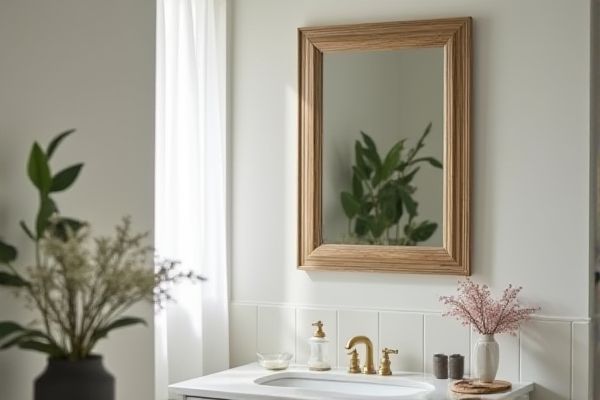
Hardwired mirrors are integrated directly into your electrical system, providing a seamless and permanent connection with often more features like anti-fog and lighting. Plug-in mirrors offer flexibility and easier installation by connecting through a power outlet, making them suitable for renters or those seeking portability. Explore the rest of the article to determine which mirror best fits your needs.
Table of Comparison
| Feature | Hardwired Mirror | Plug-in Mirror |
|---|---|---|
| Installation | Requires professional wiring and installation | Simple plug-and-play installation |
| Power Source | Connected directly to electrical system | Powered via standard outlet or USB |
| Reliability | Consistent power supply, minimal downtime | Dependent on outlet availability and connectivity |
| Flexibility | Fixed position once installed | Portable and easily movable |
| Cost | Higher initial installation cost | Lower upfront cost, no installation fees |
| Maintenance | Requires professional servicing for electrical issues | Easy to replace or repair personally |
Introduction to Hardwired vs Plug-In Mirrors
Hardwired mirrors are integrated directly into a vehicle's electrical system, offering seamless power functions such as heating, dimming, and signal lights, ensuring consistent performance without external connections. Plug-in mirrors connect via a removable harness, allowing easier replacement and customization but may have less stable power delivery. Choosing between hardwired and plug-in mirrors depends on installation complexity, functionality requirements, and vehicle compatibility.
Key Differences Between Hardwired and Plug-In Mirrors
Hardwired mirrors are integrated directly into your vehicle's electrical system, offering a seamless and often more reliable power source for features like heating and auto-dimming. Plug-in mirrors, however, connect through a simple plug, making installation and replacement easier without modifying wiring. Your choice depends on whether you prioritize ease of installation or a permanently connected setup for enhanced durability and functionality.
Installation Process: Hardwired Mirrors
Hardwired mirrors require direct electrical wiring into the home's power supply, often demanding professional installation for safety and compliance with electrical codes. The installation process involves mounting the mirror, connecting wiring within the wall or behind the mirror, and ensuring proper grounding. Compared to plug-in mirrors, hardwired options offer a cleaner, more integrated look without visible cords but require more time and expertise during setup.
Installation Process: Plug-In Mirrors
Plug-in mirrors offer a straightforward installation process, requiring minimal tools and no electrical wiring expertise, as they connect directly to the vehicle's existing wiring harness. These mirrors are designed to be compatible with specific car models, ensuring a seamless fit and quick replacement of the old mirror. You can save time and avoid professional installation costs by choosing plug-in mirrors for your vehicle upgrade.
Design and Aesthetic Considerations
Hardwired mirrors feature a streamlined design with integrated wiring that remains concealed within your wall, offering a clean and minimalist aesthetic ideal for modern interiors. Plug-in mirrors, however, display visible cords and plugs that can disrupt the seamless wall appearance but provide greater flexibility in placement and installation. Choosing between these options depends on your preference for a sleek, built-in look versus the convenience of portability and ease of installation.
Power Source and Safety Features
Hardwired mirrors connect directly to the vehicle's electrical system, providing a consistent power source for features like auto-dimming and integrated lighting, which enhances safety by reducing glare and improving visibility. Plug-in mirrors rely on external power sources through connectors, making installation simpler but potentially less reliable during power fluctuations. Both types include safety features such as heated elements to prevent fogging and blind-spot indicators, but hardwired mirrors generally offer more stable and integrated functionality due to their direct power connection.
Maintenance and Longevity
Hardwired mirrors typically offer longer durability due to their direct electrical connection, which reduces the risk of loose wires and intermittent functionality. Plug-in mirrors, while easier to install and replace, may require more frequent maintenance because their connectors can wear out or become corroded over time. Your choice should consider the balance between upfront ease of installation and long-term reliability based on maintenance needs.
Cost Comparison and Budget Factors
Hardwired mirrors typically involve higher installation costs due to electrical wiring and labor, making them a more significant upfront investment compared to plug-in mirrors. Plug-in mirrors offer greater affordability with easier installation, which suits tighter budgets or DIY projects. Considering Your budget, choosing between hardwired and plug-in mirrors depends on balancing installation expenses against long-term functionality and aesthetic preferences.
Ideal Use Cases for Each Mirror Type
Hardwired mirrors are ideal for permanent installations in home gyms or fitness studios where a sleek, professional look and continuous power supply are essential. Plug-in mirrors work best for temporary setups or spaces where you may need to move the mirror frequently, offering flexibility without complex wiring. Your choice depends on whether you prioritize stability and aesthetics (hardwired) or portability and convenience (plug-in).
Choosing the Right Mirror for Your Space
Hardwired mirrors offer seamless integration with your electrical system, providing consistent lighting and a clean aesthetic ideal for modern bathrooms or dressing areas. Plug-in mirrors deliver flexibility and easy installation, perfect for renters or spaces where rewiring is impractical. Selecting the right mirror depends on your room configuration, power source availability, and whether you prioritize permanent installation or portability.
 homyna.com
homyna.com